Visit my Home Page.
Want to send me mail? Click here: tomrdavis@earthlink.net.
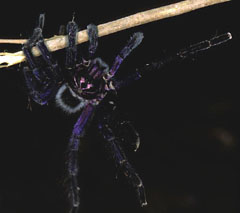
Here's a giant spider we found crawling around the camp; it is about 6 inches across. We only saw a couple of these this year, but it is the first time I have seen them since my original trip in 1996/7. That year they were all over the place. I've heard that they are called "bird-eating spiders", but have no additional evidence to back that up.
This one was simply crawling around the camp, and I hope it
wasn't blinded by the huge number of photographic flashes it was
subjected to. After the photo shoot, we were even able to
restrain ourselves from putting it in somebody's sleeping bag.
My previous three experiences on this project are also
documented on web pages. See:
1996-1997 Trip
1998-1999 Trip
1999-2000 Trip
If you are interested in the science behind the project, look at
those other pages.
The El Niño event of 1997-1998 made the trip to the Forest Birds project impossible. I was, however, in Ecuador that year as well, but in the mud of the highlands. Click on: Butterflies if you're interested in reading about that one.
This year there were 8 volunteers (Shari, Debby, Larry, BJ, Catherine, Melinda, Michelle, and myself), two principal investigators (Dusty and Ana), one staff member (John), and the two Ecuadorian helpers (Pascual and Mauricio) who have been on almost all of Dusty's projects. There was one major mishap at the beginning—BJ's luggage was lost somewhere between Kansas and Guayaquil. He managed to purchase a couple of things in Guayaquil, but had to borrow almost everything else. It would have driven me crazy, but he showed amazingly good humor about the whole thing. John and BJ are students of Dusty. What I did not realize at the time is that I was in a company composed entirely of "mental giants".
Catherine, Debby, Larry, Michelle and I were the geezers (age around 50 or beyond), Melinda and Shari had a ways to go before they rate geezer status, and BJ, Ana, and John were youngsters in their twenties. I think Dusty is not yet there, but is nearer geezerhood than Melinda and Shari. It was nice to have a range of ages—we geezers could often take advantage of the youngsters when something horrible was required: "We need more bird bags. Why don't you run back to the casita and bring us some? Make it quick!"
The general plan was the same as in previous years—on the first day we'd drive to a town called Valdivia near the trailhead where we'd spend the night, then hike in to the research site where we'd live in a small rustic building called the "casita". For nine days we'd do research, mostly catching, measuring, banding, and releasing birds, after which we'd hike out to the town, spend the night, and finally return to Guayaquil.
Guayaquil is on the coast of ecuador, and to get to Valdivia, you drive north along the coast for about 4 hours. Valdivia is also on the coast, and we stayed overnight there in quite a fancy tourist lodge that caters mainly to whale-watchers, I think. I didn't see any whales. The casita is approximately due east of Valdivia, perhaps 15 or 20 kilometers from the coast (as the toucan flies). But getting in is quite a project; there's about an hour of dirt roads to get to the trailhead at El Suspiro (which means "the sigh" in Spanish), and then about 5 hours of hiking on trails to get to the casita itself. And the trails are nowhere near level.
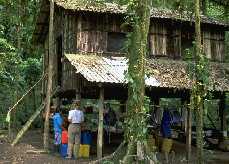
The photo of the casita on the left was taken a couple of years
ago, and it's condition has deteriorated a bit since then. In
fact, the metal roof you see in the photo was stolen during the
last year and had been replaced by temporary plastic.
Since Earthwatch sends a list of names and addresses to all the volunteers about a month before the project starts, some of us had been in contact via email, and I knew that Melinda and Michelle would be on the same flight as I was from Miami to Guayaquil. Larry was on another airline, but was supposed to arrive in Guayaquil at about the same time, so there was some chance that we'd meet him at the Guayaquil airport and share a taxi to the hotel where we were all staying.
I got to Miami on time and went to the gate to try to find the others. After looking around a bit, I saw somebody who looked sort of "earthwatchy", and it turned out to be Michelle. We talked to the check-in people, got our seats changed to be together, and then went off to the airport bar, where we each had a couple of beers (this is not a good idea, as the beer seems to need to come out the other end just as the plane is ready to take off and you're strapped into your seat). Michelle made the mistake of paying for the beers, and I quickly offered to buy her beers next time to "repay her". In the Miami airport I think the beers were about five bucks each and I knew that in Ecuador they would cost a dollar or less. We returned to the gate and apparently appeared earthwatchy enough that Melinda also found us.
Catherine also found us there which was particularly surprising for us since her name had not appeared on the list of volunteers. In fact, she had signed up at the last moment, and was a surprise even to Dusty. We think what happened is that there were in fact two last-minute signups, and Dusty had thought they were the same person. But at least there were only 8 volunteers total which is the maximum number allowed because of space considerations at the place we were staying.
The plane ahead of us at our gate was delayed, and hence so was ours, so we got to Guayaquil about an hour late. There was no sign of Larry at the airport—he'd had good enough sense not to wait for us—so we hired a small van to take all four of us to the Palace hotel where we arrived at about midnight.
The team rendezvous was at 9:00 am the next morning, so we decided that anyone who wanted to wander around Guayaquil a bit beforehand would meet at 7:00 in the lobby. I set my alarm and proceeded to sleep through it—the first time I ever remember doing so. In fact, on this trip I consistently slept through my alarm, and that has never happened before. Maybe in my geezerhood my hearing is beginning to fail.
We spent the afternoon purchasing some last-minute items including bottled and bagged water, about 6 dozen eggs, and various fruits and vegetables. We wrapped each egg individually in a piece of crumpled newspaper and loaded them all into a cardboard box, thereby putting all of our eggs in one basket. I wondered how the eggs would survive a six hour bumpy mule ride.
It was surprisingly hard to find bottled water as well. We were looking for those blue plastic five-gallon containers which seemed to be few and far between. We paid some guy to drive us around in his truck to look for them, and finally found them after going to three small towns. We were only able to get four, but supposedly there were already ten of them up at the casita, taken up by Pascual and Mauricio. The water situation was going to be tight.
Miraculously, the eggs seemed to have survived the mule trip; almost none of them were broken, or at least so it seemed. What really happened of course is that the eggs on top did well, but as we worked our way down into the box, more and more of them were broken, and the bottom of the box was a pretty slimy mess.
On the bottled water front, it seems that the newer blue bottles are not as sturdy as they were in the past. One of the ten bottles at the casita was broken on the way up, so we had only thirteen. Three more were broken in the course of the trip, and Dusty had never seen a single one of them break in all her previous expeditions.
Debby arrived at our lodge/hotel in the town of Valdivia just as we were beginning to load the truck with all the equipment we were going to take up to the casita.
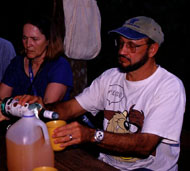
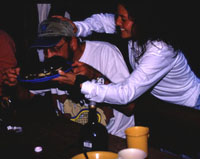
Larry's birthday is on December 31, so not only were we
getting ready to celebrate the new year, but also another year
for Larry. Larry and Michelle are on the left, and on the right
is Ana performing the "traditional" casita "push the face into
the cake" birthday ritual. The cake, of course is made up of
pancakes stacked up and smeared with chocolate frosting.
As always, the plan was to start early the next morning and have a leisurely hike up to the casita with plenty of time for birding along the way. This year things didn't quite work out that way. We loaded our stuff onto the truck that was to take us to the trailhead in the town of El Suspiro, and as we passed through Loma Alta, the main town in the Loma Alta Comuna, we stopped for a courtesy call on the president of the comuna to let him know that we were on our way up to the casita in the Loma Alta reserve.
The president wasn't in, so Dusty told a couple of other officials and we started to turn the truck around to head for El Suspiro. All of a sudden, the two officials ran up and in the blur of Spanish that came out I only caught a few words, "You can't go up there!"
While the rest of us waited in the truck, Dusty and Ana went into a building, and 45 minutes of discussions ensued. Of course I don't know what was said, but I could make some guesses. The year before I joined the project for the first time, the project had been different—it had been aimed more at aiding the community rather than a pure scientific expedition, and the group that had originally been involved was called PAN—"People Allied for Nature". Dusty and the PAN folks parted ways a couple of years ago, and the PAN people have continued to work with the community. My guess is that the folks in Loma Alta thought that perhaps there might be a way to get more money or something out of Dusty since as it is, her project only directly pays a few people—Pascual and Mauricio, the mule drivers, and Celso, the fellow whose house serves as a sort of headquarters at the beginning and end of each trip.
I think the comuna's best bet would simply be to charge an admission fee to anyone entering the reserve, either for scientific research, or birdwatching, or whatever. Dusty did have a few cards to play, however. One was that a knowledge of the birds in the reserve might attract birders, and ecotourism could certainly bring a bit more money into the comuna. Second, Dusty and a few of the volunteers had brought quite a few school supplies to be given to the school in El Suspiro.
In addition to the 45 minute delay, the net result was that we could go up, but there was to be an official presentation of the school supplies to the school, and that at the end of the trip, Dusty and Ana were to give a presentation to a larger group of members of the comuna.
Of course when we arrived in El Suspiro there were no mules waiting for us even though we were an hour late, so the search for mules and mule drivers was set in motion. When the mules came, most of us went to the school to hear the presentations, but Ana and I stayed behind to supervise the loading to make sure that the right stuff got loaded.
Finally, at about noon, we were ready to go. The sun goes down at about 6:00 pm, and if you walk steadily at an easy pace, the trip takes about 5 hours. We walked a little faster than that and did a small amount of birding, and people arrived at the casita between about 4:45 and 5:30, so there was sufficient time to set up the mosquito tents, sleeping bags, et cetera with a little daylight left over. Mauricio and Pascual had cooked us a dinner, so after a fairly strenuous hike, it was nice to be able to relax.
Also on the way up Shari, who is an anthropologist, among other things, found various pottery shards and stone tools on the trail to the casita. I would never have seen them in a million years, but with an expert to point them out, it was obvious that they were man-made.
I'm paranoid about running out of water on this hike, so I normally carry a heavy load, and this year was no different. I have one of those "Camelbak" backpacks that includes a bladder of water that you can suck out of a hose, and the bladder holds nearly three liters. I also carried two one-liter bottles in the side pouches. But in addition to that, since we were going to be spending the new year at the casita, I also carried a champagne bottle and a bottle of rum. We didn't trust the mules to get the glass bottles up in one piece, especially after an unfortunate experience the year before when a volunteer found his broken bottle of whisky in the center of his pack after it came off the mules. In addition to losing the whisky, his clothes reeked as if he were an alcoholic who had just crawled out of the gutter for the first week. Ana was carrying another bottle of rum and a bottle of home-made eggnog. I think Larry was carrying another bottle of rum, and Melinda had a bottle of amaretto. All was in glass bottles, of course, and all of it survived the trip.
One of my favorite birds is the Swallow-tailed Kite, and the pasture is a great place to see it, since there is a tremendous view in all directions, but we didn't seem to be having much luck with it. I joked that I wouldn't leave until I'd seen it, but it would be a pretty miserable night up there alone. It was getting to be time to leave, so we counted up the number of different species we'd seen, and it was 39. We decided to wait for a nice, round 40, when what should I see but a Swallow-tailed Kite—bird number 40!
The date was December 31, and the most important job was already finished—making the muñeco for the new year celebration. A muñeco is a dummy that represents the troubles and sorrows of the previous year and it is burned at the new year to get a sort of clean start. Of course there is no reason not to make the doll look like someone recognizable, and you can purchase many different paper-mâché dummys in the form of local politicians and other things. The previous year, since we didn't know any of the Ecuadorian politicians, we had purchased a dummy of Bart Simson and burned him. Here are the glorious details.
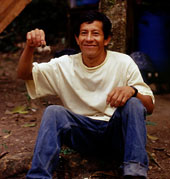
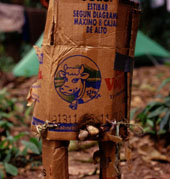
Here are a couple of photos of our muñeco in the
process of construction. On the left is Mauricio with the
"huevos" (made from tagua nuts; see below). On the right is the
completed "anatomically correct" portion between the upper legs
and the lower torso.
This year all we got was a paper-mâché head of a man since it was so much easier to haul up the hill, but when we got to the casita, we had to make the rest of the dummy. Luckily, Pascual and Mauricio were experts at this. Using sticks and cardboard it was easy to make the arms, torso, and legs. Normally the muñeco is dressed in worn-out clothes, but since this was only the second day at the casita and since nobody packed any worn-out clothes, those were a bit hard to come by. John did contribute a T-shirt, but nobody wanted to contribute any pants.
By this time we had decided that the president-elect, George "Dubya" Bush, would make a good model. We painted a "W" on the forehead of the muñeco so there would be no question as to its identity, and stuffed the cardboard torso with explosives (well, firecrackers, actually). The search for pants proved hopeless, so we decided that he'd just have to be bottomless, and as long as he was bottomless, at least he ought to be anatomically correct. A stick and a couple of tagua nuts did the trick, after the stick was suitably shortened, and then an unnamed volunteer decided that a nice clump of moss could be used to accentuate the artwork. With a tube stuffed in the nose to snort cocaine, the muñeco was complete.
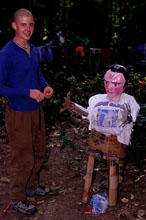
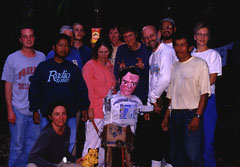
On the left is BJ with the essentially completely constructed
"Dubya". The tube for snorting cocaine has not yet been
installed, however. On the right is a photo of the group except
for Ana, who was the photographer. Melinda is in the lower left;
standing from left to right: John, Pascual, Debby, BJ, Michelle,
Shari, Dusty, yours truly, Larry, Mauricio, Catherine. And of
course, in the center, Dubya himself.
We also had a small paper-mâché model of one of the Pokeman characters which we also figured everyone would enjoy burning.
We then asked our Ecuadorian informants about the proper timing for the conflagration. They said that normally the muñeco was torched at about 2:00 am since the drinking started at midnight and it took a couple of hours for people to get drunk enough to light the fire.
We knew that we'd never make it up until midnight, so as usual, we planned to celebrate the new year in London or maybe the Azores at 7:00 pm or 8:00 pm. I think the drinking started at 7:00, and we apparently can't hold our liquor as well as the Ecuadorians, since by 8:00 the pyromaniacs in the group (there were 13 in all) were starting to light Dubya's fire.
In case three bottles of rum wasn't enough, I had brought (packed in a plastic Nalgene bottle) a liter of "everclear"—pure grain alcohol at about 90% purity (that's 180 proof). The party was so successful that indeed we did have a few milliliters of everclear at the end. This was after two boxes of wine and three bottles of rum. I wondered just how bad the hangovers would be on the following day.
Except for Dubya and the Pokeman, a great time was had by all; many photos were taken, there was much singing and dancing and shouting of slogans like "Die, Pokeman, die!" (and less polite ones for Dubya). Our drunks were all well-behaved, there were no machete fights, and I think pretty much everyone was in bed by 10:00 or 11:00. We didn't even set fire to the casita, and everyone still had all their fingers and eyes after playing with the firecrackers. We set our alarms for 4:45 the next morning to get the mist nets up in time for the sunrise.

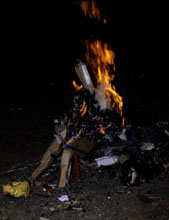
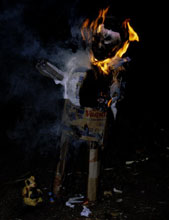
On the left is Ana lighting Dubya's fire. On the right are a
couple of photos of the fire in progress. In the rightmost, he's
lost his head entirely. You can see the Pokeman on the ground to
the left of Dubya.
We had a pretty good crew of volunteers this year. Both Melinda and I had a fair amount of previous experience with mist nets, Michelle had handled birds a lot (but not too much with mist nets), and both Larry and Debby were birders. Melinda was an amazing birder—she'd never been to Ecuador before, but had studied the birds and their songs so much that on day one she was far better than I'll ever be. Obviously the staff (Ana, Dusty, Pascual and Mauricio) also had a huge amount of experience, but only Ana, Dusty and Pascual measured the birds, so after the first net run, they were pretty much stuck at the banding station, assuming that we were getting a fair number of birds.
The way mist netting works is this: A bunch of nets are set up, and while they are open, they are visited approximately every half hour (and more frequently if conditions are bad so the trapped birds don't hang there too long). Trapped birds are untangled (this can be quite a zen experience: see Zen and Mist Nets) and are put in cotton bags where they are carried back to the banding station. At the station, the bags are hung on nails corresponding to the net number and are processed as quickly as possible, after which the birds are released.
I didn't take any photos of the mist nets this year, but there are some photos of mist nets in operation in Peru on this page.
The processing involves various measurements (the weight, the lengths of wings, tail, beak, et cetera) a general examination of the breeding condition, and a check for parasites. The bird is banded (a small aluminum band is put around its lower leg), and for some key species, a tiny sample of blood is also taken. The bird is then released, or, if it's a hummingbird, it's often fed sugar water first and then released. We try to process the hummingbirds first since they are the most delicate.
Since on the project there were plenty of volunteers, one person (Ana, Dusty, or Pascual) does all the measurements and reads out the results to a volunteer who is writing the data on a piece of paper. You can do this without a scribe, but it's a bit slower, and if there are people available, why not use them?
Also, on a project like this, many of the volunteers had never worked with a mist net, so at least initially, teams of two or three people walked the nets. The art of extracting birds could be taught to the newcomers, and after a few demonstrations, they could begin by trying to extract some of the less complicated birds. With only two weeks, however, it was best to keep teams of two for the people with less experience, since if they ran into trouble on a particularly nasty tangle, one of them could run back to the banding station to bring someone with more experience. This year I saw one of the worst tangles I have ever seen in my life, but luckily Mauricio worked on it. We came to a net with two birds and after I got mine out, I headed back. 10 minutes later, Mauricio was still missing, so I went back to the net and he was still working on the same bird. It proved to be so hopeless that we finally got out the scissors and cut a few threads. I had never seen Mauricio have to cut before.
After a couple of days, everyone had gotten a chance to try everything and people then tended to do the jobs they liked. Some folks loved to work with the birds, others preferred to help with the banding and note-taking.
During the first banding phase, the banding station was at the casita itself, with two "traplines" of 10 mist nets each going off in opposite directions. It's a great way to start, since all the equipment is there, and as long as it made it to the casita, it's available.
This year things were dry, and that caused the relative difficulty of the two sets of nets to be swapped. One of the routes heads steadily downhill with some fairly steep parts, while the route on the other side is more level, but much longer. Last year, when things were wet, the steep downhill side remained pretty dry, while the long route was a sea of mud the whole way. We called the downhill route "Club Med" and the muddy side "Devil's Island". This year, although the route was longer, the level route was basically just a stroll, while there was a pretty steep climb out of what had been the Club Med side. The Devil's Island side was better, however, if you were interested in catching birds. I'll retain those names in the discussion that follows.
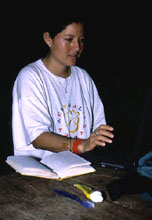
Here is Ana writing the code for a computer virus to take
down every computer on the internet. Unfortunately, when she
finally had it perfected, she realized that the web connection
from the casita was pretty flaky (it ran at a very consistent
zero bytes per second), so she erased all her work and did data
entry instead.
All of us would come back during the first run, since it and the second run usually yielded the most birds. We'd take all the captures back to the banding station where we'd wait 20 minutes or so, and then head back to the end of the nets with three or four people, taking the birds out of the nets as we found them. You can leave them in bags at the nets where they were captured, and when we got to the end of the line, we'd send a "runner" back to take all the bagged birds back to the station. The "runner" of course, was usually a youngster, although Catherine (a marathon runner in her spare time) liked to do it as well. Then the others would wait for a half hour, just as when we opened the nets, and then would head back to the station. This was repeated for 5 hours, giving us 100 net-hours (5 hours times 20 nets) each day.
We repeated the same setup for three days, all with perfect weather, and of course the catch was less each day since the birds do learn something in spite of the fact that they're equipped with bird-brains. Unfortunately, we did have a hummingbird that died in the net. There seemed to be nothing wrong with it, and it had been there for at most a half hour. It was clearly dead when we got there; it's little feet were locked to the threads of the net, and hummers never do that normally. It was very sad.
One of the most horrible things I had to do was to deal with a couple of hummingbird-sized bumblebees that got tangled in the net. With most insects except for beetles you can easily untangle them just like you would birds. Beetles just have far too many joints and they always seem to get the nets under the hard other wing and it's a total nightmare. But the bumblebees were terrifying. You could see the abdomen slashing around and the stinger extended and withdrawn repeatedly. Sometimes, if the bee was obviously on one side of the net and not badly tangled, you could get on the other side, stretch out the net from a safe distance, and hope it got loose. But usually the tangle was hopeless and the only thing to do was to kill the bee and remove it piece by piece. At least my Leatherman tool had a large pair of pliers to make the killing occur as fast as possible.
The tasks that needed to be done included entering the data into a computer (a laptop hooked to an automobile battery), getting water (more on this later), cooking (although this was assigned each day to pairs of people), making various repairs, washing your clothes, washing yourself, et cetera. Some days, of course, there was a lot to do. If the nets needed to be moved or taken down that took a lot of people a couple of hours each.
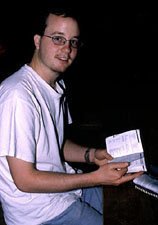
When not doing something in the above paragraphs, people went
hiking, birding, they read books, played cards, slept, or
commented on other people doing one of the above. John and BJ
spent quite a bit of their free time learning dirty phrases in
Spanish. On the left is John learning the language necessary to
make a drug deal in Guayaquil.
I think it was during the card playing that the group first became aware of the fact that everyone on the trip was a mental giant. The initial flash of genius that tipped us off that we were not in ordinary company was the revelation that all those games of solitare that we'd wasted so much time with on the computer could be played with actual paper cards! Then, when someone actually won a game of solitare, our mental giant status was confirmed. After that, it was easy to find examples of our mental gigantism—putting the cups on the table upside down before dinner prevented bugs from getting into them, using one bowl for both soup and the dinner cut down on washing, zipping your tent closed during the day to keep bugs out, rolling your socks over your pants kept other bugs out, and the list was seemingly endless.
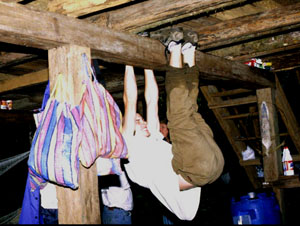
BJ practiced being a monkey (he said he was practicing
rock-climbing, but we all knew better) and tried to swing across
the area under the casita without touching the ground. Of course
on each trip, he managed to knock large numbers of cans of food
off the rafters, but fortunately, not too many of them hit him
squarely on the head.
Another spare time activity that proved surprisingly popular was tagua carving. Tagua is also called "vegetable ivory" and is the nut of a palm. Without too much trouble you could find them scattered all over the place. Here are some photos of tagua and tagua carvings from a previous trip.
When we stopped at El Suspiro on the way in, we were offered the opportunity to purchase some tagua carvings, mostly earrings and rings, but other things as well. The items we purchased were very nice, but we thought, "How hard can it be to make this stuff? All you need is a knife and a tagua nut."
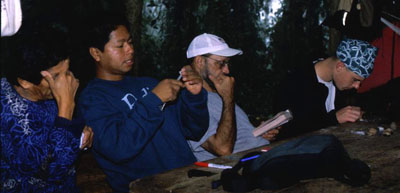
Here are three tagua artisans at work and Larry. From left
to right, we have Mauricio, Pascual, Larry, and BJ.
Some of the stuff we produced was pretty good. Pascual and Mauricio made some nice stuff, but that wasn't really fair—they had worked with the stuff before. BJ made quite a few rings, and toward the end they were starting to look pretty good.
My fantasy was to make a chain of linked rings from a single tagua nut and I kept trying to talk other people into doing it for me, but with no success whatsoever. So on the rainy day I finally tried to do it myself. It took hours, and the result was ugly, but I did get two interlocked rings from one nut. The wounds on my hands from slips of the knife even healed eventually. I did it by cutting with a saw what looked like an extruded cross and then I cut away everything that didn't look like two interlocked rings.
One of us (BJ, I think) discovered that if you crammed the tagua nut into a knot hole on the table before starting to saw on it you got less injuries than if you held the nut in your hand as your sawed. This was yet another proof of our mental giant status.
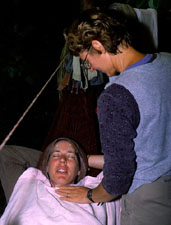
As you'd expect, on different days different crazy things
were done. One morning the cooks made far too much oatmeal for
us to eat, and somebody (Shari?) got the idea of using the
leftover oatmeal to give facials. There were a number of people
who took advantage of the casita "spa". Here's a photo of Shari
herself getting an oatmeal facial from Dusty.
In fact, along with the spa, we came up with a great idea for turning the Loma Alta comuna into a giant money-making enterprise for the locals. Just market the whole project as a weight-reduction clinic. It could be called "Dusty's Fat Farm", advertised as follows, "If you come to Dusty's Fat Farm and participate in all the 'activities', you can eat as much as you like and you'll still lose weight." We weren't quite certain how we'd treat the heart attacks of overweight people trying to lug 50 pounds of water up a steep trail, however.
In the evenings, after all the sensible people had gone to bed, the poker games started. We played with matchsticks, and everybody got 50 of them to start with. As soon as somebody went broke, whoever had the most sticks at the time would give away half of them so that the busted player could continue. Unfortunately for those who were trying to sleep, the games were often quite boisterous.
Playing poker or just talking I was usually up until 11:00 pm, so by the time I got home I had a huge sleep deficit to make up. I suspect that many of the others were the same.
And if there weren't enough other things to do late at night, there was owling. We only did it for a couple of nights, but it was a lot of fun. Ana, Pascual and I took off at about 9:00 pm with flashlights, binoculars and a tape of owl calls and headed up toward the ridge. We'd find a likely spot, or hear an owl calling, and then we'd start playing the tape. If an owl of the correct species heard it, he'd come closer to investigate. When Ana and Pascual judged that he was close enough, we'd turn on the lights and try to find him.
We heard a lot of different types, but only got one really good look at a Tropical Screech-owl. Luckily, there was a fairly full moon, since when we were playing the tape and wanted to change position, we didn't want to turn on the lights, so we were hiking around in the dark, off trail as much as on. I still haven't figured out how to hold both the flashlight and the binoculars steady at the same time, to say nothing of having them both pointing in the same direction.
I only saw one other owl on the trip, but it was in broad daylight on a power line. It was the Pacific Pygmy-owl, closely related to the Ferruginous Pygmy-owl that I'd seen many times in Costa Rica and which I believe can be found in the southern US.
To help people conserve water, I suggested that everyone take a turn going down and hauling up a load, rather than having Mauricio or Pascual get all of it. The spring filled a small pool pretty slowly, so only about 15 gallons were available every day—about a gallon per day per person. Just one trip up that hill with a heavy load is enough to convince most people that perhaps a couple of liters for a shower/bath should be sufficient!
We only had two reasonable types of containers to carry the water -- one was the five-gallon blue bottles that the mules had originally hauled up the hill with potable water, and the other was a ten-gallon plastic container with a handle. We retired the five gallon size after Larry demonstrated how easy it was to break them (nearly killing himself in the process). He tripped on a log coming up a steep portion, he went down, the bottle went up, and then down again, barely missing him, but shattering impressively on impact.
But the ten gallon containers were also a giant pain. They were certainly tough enough to stand a little battering, but if full, they weighed 80 pounds which was a totally unreasonable amount to carry up the steep slopes. But if they only contained 5 or 6 gallons, the water sloshed around inside and they were terribly difficult to balance on your shoulder. It was sort of fun getting the water, however. We found that a team of three people and two 6-gallon loads worked pretty well—somebody got to rest while the other two staggered up the hill and we switched off every 100 meters or so. Of course there were also the end-game strategies to make sure you were carrying the water at the end when you got to the casita to be sure to get the glory.
Sometime during the year, the new metal roof over half of the casita had been stolen, so it was temporarily replaced by plastic sheets. This worked great until it actually started to rain.
The roof of the casita was composed of boards forming rectangles about one meter on a side with plastic stretched over them. There was also a similarly covered awning over the cooking area. But when the rain started, the water tended to pool in the centers of the rectangles and in our heaviest rains, the roof drained fairly well (with one notable exception) but the awning's pools began to look quite frightening.
The first attempt to relieve the pressure was to use a broom to push up on the pools from below so that the water would drain off the edge. Then it occurred to people that the water on the plastic was probably at least as clean as the stuff we were getting from the spring, and that we should try to catch it. (Normally this would not be true, since the roof is covered with monkey shit, but the plastic was brand-new, and there had been no monkeys overhead since it was installed.) So somebody would stand at the edge of the awning with a big cooking pot while somebody else pushed with the broom. We did get some water this way, but there was accident after accident, and all the catchers wound up with all their clothes totally soaked.
So the next bright idea was to punch a small hole in the bottom of the larger pools and then to put pots under the holes to catch the stream. But it's impossible to punch round holes with a knife, and the slits produced seemed to spray water in every direction. We found a great solution—mental giants that we were—we stuck pens into the holes cap first so that the pen clip hooked onto the plastic. Then the water tended to flow down the pen and form a nice stream that held together all the way to the pot on the ground. Another mental giant named the new invention: the "penus".
We probably captured 15 or 20 gallons of fairly clean water in this way.
Sometimes, however, I suspected that not all of us were mental giants. BJ decided to do some community service and use the broom to empty the one really ugly-looking pool of water hanging over the sleeping area of the casita. Suddenly, there was a huge splashing noise inside followed by BJ coming down the stairs to hang my bedding on the clothesline. All the water in the pool had come through the joint between two sheets of plastic, and much of it had been dumped into my bed. Luckily the sun was out and I was able to sleep in a relatively dry bed that night.
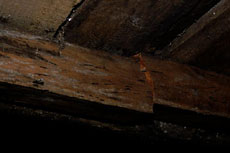
The missing roof was not the only structural problem
exhibited by the casita. On one of the first nights as everyone
was getting into bed, there was a sharp cracking sound followed a
few seconds later by one not quite so loud. Investigation the
next morning revealed that two of the main support beams for the
floor had snapped and the floor sagged dangerously at that
point. A pair of logs were cut by Mauricio and with a bunch of
us lifting the floor from underneath, the new temporary beams
could be pounded into place. Toward the end of the trip, there
was another loud snap as somebody stepped through a floorboard.
This left a hole about 3 feet long and a foot wide in the middle
of the floor and we just lived with it for the final couple of
days. Stuff seems to rot away pretty quickly in the tropics. On
the right is a photo of the broken support beam.
The first order of business was to measure out the transects. We split into teams of four, and I was on Ana's team together with Michelle and BJ. We had a 25 meter measuring tape and a roll of yellow flagging tape to mark each 100 meters. After about 50 meters we got a great system going and we may have the world record time for measuring 1000 meters.
Ana was at the front and I was at the back and we had the 25 meter tape completely extended between us. I would wait at the last spot and would yell "Stop!" when she hit the end of the tape. BJ was about 8 meters behind her and Melissa was 8 meters behind him. The trail twisted around quite a bit, but when I'd yell "Stop", BJ could usually see where Ana was, and if not, he'd take a couple of steps forward until he could see her. As soon as he knew where she was, he'd yell "Go!" and we'd all start moving with BJ stopping where Ana had been. As soon as Melissa saw where BJ was, she'd let him go and stand in the spot until I saw where she was and could stop there to measure the end of the next 25 meters. In other words, we basically moved forward constantly.
Surprisingly, the hardest thing to do was to count to four to make 100 meters, and to remember the number that had been written on the previous 100 meter flag. When it was time to do a flag, BJ would write out the number and tie it to a suitable tree near where Ana had stopped, and then he'd have to run ahead to get to his normal position 8 meters behind Ana. After it was over, Melinda pointed out a good way to keep track of one of the counts: Before you start, write "100 M" on the first flag. Then whenever you tie a flag to a tree, write the next number down to be ready for the next spot. Then all you have to be able to do is to count to four, and with a team consisting of four mental giants, usually at least three of us got to 4 at the same time.
Of course as we went along we kept trying to do things faster and faster, so the final 400 meters or so was done basically at a jog, with BJ having to sprint from time to time to maintain his position. The only serious problem I had is that the conditions on jungle trails are fairly erratic, and Ana, even though she's clearly a mental giant, from time to time forgot exactly the conditions of the trail precisely 25 meters behind her. I'd be trying to step over a log at the same time Ana would hit a flat stretch, she'd speed up, and I'd have to yell a four-letter word different from "Stop!"
For me, the first actual walking of the transect was far less interesting than marking it. Everybody went, so I was in a team of 6. I was last, so I never saw anything that others hadn't, and I missed most of what they did see. I know nothing about the bird songs, so I was basically useless. We brought this up that evening (others had felt the same as I had), and the next day the teams were limited to three, and I was number two, and it was far, far better. On the first transect we did see one amazing sight, however, and even I got a good look. In one tree there were at least 3 Chestnut-mandibled Toucans, at least 5 Crimson-rumped Toucanets, and at least 3 Crested Guans. 11 giant birds all in one tree for a long time chowing down on large quantities of fruit.
With 20-20 hindsight, it probably would have been better to do the transects at the end of the trip instead of the middle. The netting data is much more valuable if it is done the same way each year, and every year up until then, the data was taken for three days of netting. After the transects, we only had four days left and we were rained out on one of them. One more day of rain (and it certainly threatened to do that a couple of times) would have eliminated the third day of netting. This was the first year for the transects, but the fourth year of netting so there was much more at stake with the netting data. We should have used the first six good days to net, and then done the transects in whatever days were left. But we were lucky, and got all the netting days.
Mauricio did all the work, hacking away with his machete from time to time, and we marked a 500 meter trail that was very steep and ran the entire distance. I was not at all confident that others would be able to follow our trail, so Shari and Pascual decided to see if they could do so and find all the flags. For me, 25 meters is about 18 paces, so you find out fairly soon that you're mixed up, and in fact they did not have much trouble—at least with the trail marks.
They did, however, stumble across one of the most dangerous snakes in the region, locally called an "equis". This is the Spanish name for the letter "X", and the name comes from the fact that the back of the snake is marked with what looks like a series of Xs. It's also called a Fer de lance, and the scientific name is Bothrops asper. Anyway, it scared the piss out of Pascual, and Shari didn't seem all that pleased, either. They said that for the first half of the stroll they had been birdwatching, but for the last half, all they could bring themselves to do was snakewatching.
I only saw a few snakes this year, none of which were Bothrops. The first two were small and slithered off the trail in front of me, one was spotted by John at the lodge in Valdivia (good eyes!) where we stayed after the trip, and the other one I stepped on.
Pascual and I were going down the trail, in a hurry, as usual, and Pascual was walking a couple of meters behind me. All of a sudden he shouted and jumped back and I was lucky to spot the tail of the snake as it raced into the bushes. I had apparently stepped on it, and it had reared up and squirmed around enough to raise Pascual's heart rate by about 100 beats per minute, but although it was relatively large (perhaps a meter long), it was harmless, and I can't imagine that I hurt it much since it was in mud. Although they're not very stylish, I always wear rubber boots up to my knee; I can't imagine why other people don't do the same.
The idea was the same as down below, but one of the runs was longer, and there were a lot more birds. On the first day, we caught about 150 of them (the previous all-time record at any of the casita sites had been a bit over 100). The poor banders worked like crazy and the extracting team also had to keep on its toes. It's amazing how easy it is to run out of the bags, especially when below you would almost always be in good shape if you had five or six of them in your pocket.
In fact, an incident occurred relative to the bags that made me wonder again whether BJ was, in fact, a mental giant. It was on an early run on the first day, and there were so many birds that by the time we got to the third net from the station (out of 10) we were already running a bit low on bags. But there were 7 birds in that net! I told BJ, "Give me all your bags, and you run back to the station and bring back a shitload of them."
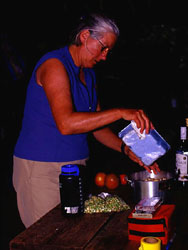
Here's Debby taking one of her turns as cook. This is
obviously a photo taken early in the trip; the first bit of
evidence is the relatively clean clothes, but the kicker is that
there's still a bottle of rum remaining, visible in the
right-most part of the image.
I was pretty bummed out when I found out later that I probably killed a bird. A Silver-throated Tanager arrived at the banding station with one of its wings apparently dislocated, which is essentially a death sentence for a little bird. He was from net 13, and I had taken a Silver-throated Tanager from that net, so it was probably my fault. I don't remember any problem with him—he came out easily enough, but I was in a big hurry with the net full of other birds, and I was probably too rough. I felt horrible about it, and the only good thing about it was that I became incredibly careful for the rest of the trip.
I did add a couple of bits of knowledge to my mist-netting knowledge. First, I discovered that Rufous-tailed Hummingbirds are small enough to go completely through a net, which is how he escaped. Second, I found just how fast hummingbird wings beat. A hummer had hit the net so his head was through a hole in the mesh, and when he fell down, his head also went though another hole in the mesh in the lower loop of net. I'd seen that dozens of times before, so I grabbed him from behind and released his head from the lower hole. Then my hand slipped for just an instant, and he got loose with his neck still through one hole in the mesh. He started flapping his wings, but one was tangled slightly so only one wing worked and he spun like a top. I'm sure I got my grip within a second, but by the time I did, the net from his neck was twisted into a cord. It was totally obvious how to get him out; I just had to unwind him, but for the heck of it, I counted the turns. He had done 9 complete revolutions in less than one second!
The next day it was pouring rain, so there was no netting, and instead the tagua artisans went to work cutting their fingers to ribbons.
The next day was pretty iffy—dribbling rain, and threatening to start raining hard at any moment, but we did open the nets. Even if it wasn't raining, the trees were full of water from the earlier rain, so water was coming out of the sky, and some people might call that rain anyway.
You don't want the birds to get caught in the rain since they get chilled pretty fast and it's an easy way to kill them. So early in the day we decided that we'd visit the nets every 10 minutes so that at least if they were wet, we'd get to them in a real hurry. This was a real problem on the longer run, since it probably took ten minutes just to walk the length of it in good conditions, and given all the mud and the likelihood of finding entangled birds it could take much longer.
The other side was actually in the form of a "Y", and it did not take too long to get people out to the ends and back, so we got together a special team for the long run consisting of three of the best bird untanglers—Mauricio, Melinda and myself. We also took a fast runner, Catherine. Pascual is also very good, perhaps the best untangler of all, but he also measures birds and would be available to take care of any nasty tangles that occurred on the other side.
All four of us would go from the banding station as quickly as we could to the far end, removing from the nets any birds we found. We'd leave those birds by the nets they were removed from. As soon as we got to the end, the runner would turn around and gather all the birds on the way back, possibly removing one or two on the way. Then, every ten minutes, one of us would leave from the end toward the station, taking in the birds we got. Then they entire process was repeated as necessary.
It's essential to know from which nets the birds came. Since there were ten nets and most people have ten fingers, it's usually not hard to keep the nets straight. On the nets near the casita, the numbers were simply one to ten on each side, so if you assigned numbers from one to ten to your fingers, you'd just hang the bags from the appropriate fingers on the way in. But the nets up top were in chaotic order, due to certain historical quirks, and to be able to compare the numbers from year to year, the bizarre order needed to be maintained. Some people just wrote numbers on their fingertips.
My favorite bird was the Slate-colored Grosbeak. It's a sort of gray bird, but with a massive red beak that appears to be missing a few parts. I can also assure you that it's got a very powerful bite. We also caught for the first time in many years the Little Woodstar hummingbird. It is so tiny that it is a miracle it got caught in the net at all; it's the size of a large bumblebee.
We did not catch one, but we did see the Esmeraldas Woodstar—another tiny hummingbird that's quite rare. Ana went nuts when she saw it, she was so excited. We even set up some nets where we saw it, but were unable to get our hands on an individual.
Anyway, we had timed things so that dinner would be ready at about 6:15, but Dusty and Shari were out hiking. At about 6:00, we started to see a bunch of termites flying around outside the casita, and every now and then one of them would fly into the casita, so we covered the flan as well as we could as it jelled to make sure we didn't get a bunch of termite parts in it.
By 6:15 the situation had changed; there was still no sign of Dusty and Shari, but the bunch of termites had turned into huge black clouds of flying insects. Michelle asked if we should be worried about our missing members, and got no real response. Then somebody else asked if they had flashlights, and Melinda replied, "Well, either they do or they don't!" We decided to eat because the termites were getting worse, and besides, Dusty and Shari were big girls.
But just as we started serving, the termite swarm entered the casita. There were literally millions of them. As they hit the ground or any other surface, their wings fell off, and they started crawling around, looking for a place to burrow in. The surface of the soup and of the flan became black with termite wings. Everyone's clothes were covered with wings, and with termites crawling all over the outside and inside.
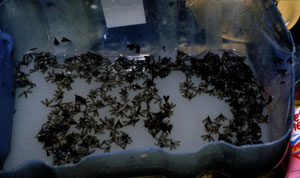
I didn't take any photos of the termites when it happened,
and we cleaned up most things that night. But we didn't clean
the hand-washing "bowl"; here's a photo of it the next morning.
Almost everyone just went ahead and ate the meal with a bit of extra protein, but there was at least one person who passed. It was extremely difficult to relax with insects crawling all over your body when nothing could be done about it. I just tried to sit still, relax, and eat normally. I think I did fairly well as did a few others, notably Melinda and Ana, but there were a few folks who were notably stressed.
Finally, the swarm began to die down, and all that was left were millions of termite wings in a thin layer over absolutely everything. Washing up after dinner was no fun at all, I can assure you.
Just as the plague of termites was beginning to subside, Dusty and Shari appeared, and almost instantly, Dusty asked if anyone were worried about them. She got a joking reply, and we thought that was the end of it.
But the question kept coming up, and it finally turned out that Dusty and Shari had placed a bet on whether the group had been concerned about the fact that they were not back, and if we were planning to send folks out with flashlights or something. There was a dinner in Guayaquil riding on the result.
So "testimony" was taken, and of course it did not settle the problem. In fact, as the process went on, even the details of the bet seemed to change. Was the fact that Michelle had said, "Should we be concerned?" in fact a demonstration of concern? It was a difficult legal question. And the fact that we did not know their staus relative to flashlights—did that indicate that we thought that a search party with flashlights might be required? Things became murkier and murkier and nothing was settled.
Then the next day at the banding station the two of them began arguing again, and they again began taking testimony from any witnesses who happened to be around, with no better results than they'd had the night before. It went on and on, so the rest of us finally appointed Debby as the chief justice of the supreme court and she promised to render her decision at dinner that evening. She didn't take any additional testimony; she was as sick of hearing it as the rest of us. Everybody, including Dusty and Shari agreed that this was a good solution, but within minutes, they were arguing again. Debby put a quick end to that by threatening them both with contempt of court.
She seemed like an iron judge at the banding station, but was unable simply to render her decision at dinner. We had a formal calling of witnesses again, together with the usual cross-examinations. Finally, in a surprise move, Shari called Dusty to the stand as a witness for her side. Of course no additional information was generated; just smoke, no fire.
Finally, with skill rivalling that of the US Supreme court in its decision to stop the counting of ballots in Florida, Debby issued a murky decision that, as far as we mental giant legal interpreters could determine, amounted to, "You two had better settle this yourselves." But it was a pretty entertaining way to spend an evening, even though it didn't end with a jail term or an execution.
After that, I always took extra care to use plenty of repellent on my hands and face, especially in the early evening when most of the mosquitoes bite. I also made sure that my pants were stuffed into my socks to avoid the entry of various creatures at my ankles. I think you have to have one really bad experience with insects before you take them seriously. I'm pretty sure that this trip provided that experience to a number of the volunteers.
There were some mosquitoes, and in spite of my precautions, I got a few bites, but they were nothing compared to the chiggers and ticks. Chiggers are little mites that dig into your skin and itch like crazy. They almost always dig in where there are tight-fitting clothes—under your socks, at the waist of your pants, or if you're a woman or a transvestite, under your bra. A good place to get them is in pastures, and we spent a lot of time birdwatching in a pasture up at the top of the hill.
Permethrin kills chiggers, and if you're wearing double socks, one inside and one outside your pants, and then rubber boots over the entire mess, they can't get in at all. I had zero chigger bites, and there were volunteers with hundreds. The same sort of protection works against ticks, and I had zero of those as well.
But almost everyone else sported at least a few, and some people had many. I think that when you get enough bites, your immune system somehow goes over the edge and you get a systemic reaction that makes the itching ten times worse. I'm pretty sure that's what happened to me with the mosquito bites a couple of years ago, and it certainly happened to a few of the volunteers this year. I felt really sorry for the victims, and there was a great deal of cortisone, lanacaine, and benedryl used during the trip.
The ticks presented an even nastier problem, and lots of people seemed to get lots of ticks as well. They are tiny ticks in Ecuador, not like those we get here in sunny California. For that reason, the women would often go to the shower in groups of two or three to pick off each other's ticks; the men would rather have died. In fact, the communal showers seemed to save a lot of water, and Dusty suggested that maybe next year the way to encourage those would be to let larger groups of showerers have priority over smaller groups. When you wanted to take a shower, you always had to ask who was in front of you, and you'd usually get an answer like, "Larry's in there now, then me, then Dusty. You're after Dusty."
Since I always wore the rubber boots outside of camp and always had the double socks, et cetera, I has a lot sloppier about things than other people. This became obvious one day when Catherine and I decided to spend our free time in the afternoon looking for animal tracks. Catherine was interested in mammals, and in fact had done a previous Earthwatch trip chasing after mountain lions in Idaho in the winter. We had the book on neotropical mammals, and it contained a bunch of drawings of the tracks made by various of the local mammals.
Dusty suggested that we talk Mauricio into helping us. I think that in a past life (and perhaps even now), Mauricio was/is a hunter. We certainly didn't want to impose on him, so we were a little afraid to approach him, knowing that he'd say yes, no matter what he felt. So we asked Dusty if there was a reasonable way to find out. She told us that she'd already talked to him, and that he was both excited and terrified to go out. He was terrified because he had never been a guide for gringos.
In any case, it was a highly successful walk, even though we didn't find all that much. Mauricio knew tons of stuff, not only about animal tracks, but about most of the plants as well. He only speaks Spanish, of course, but Catherine could follow most of it and I could translate most of the rest. We found some amazing flowers with a strong, almost artifical-smelling odor that reminded us of something very familiar. Of course when we got back with the flowers, one whiff by an unbiased observer was sufficient for her to tell us, "It's bananas, you idiots—oops, I mean you mental giants." In any case, we did find tracks of the peccary (wild pig), of the coatimundi (a raccoon-like mammal), of the guanta (paca—a giant rodent), and perhaps of a Tayra, a member of the weasel family. No jaguars, but we did come across a fairly large wallow made by some peccaries.
I think Mauricio had a good time too; we didn't give him a lot of grief.
But (remember that this section is on bug bites) on the way back to the casita we ran across a fairly large army ant raid. I find them incredibly interesting. I like to see the insect parts they're hauling back, to look at the giant variation in individuals in the same group that are simply members of different castes, from tiny ants to soldier ants with massive heads and jaws. So I was pointing all this stuff out to Catherine when she suddenly started to get bitten, and the army ant bites are not very much fun. She was just wearing hiking boots, and although I think her pants were stuffed into her socks, the ants bit right through it. I, of course, was oblivious to the danger, since I had on my rubber boots. Most of the ants couldn't even climb them, and if I stamped my feet every now and then it was easy to get rid of the ones that were approaching the tops of the boots.
Anyway, we had to flee up the trail for 30 meters or so just to get out of the main column of ants so Catherine could pick the little buggers out of her socks. When we got back, we of course got in big trouble with Melinda when she asked us what birds we saw and we told her we weren't paying any attention to birds. Any birder worth his or her salt always looks for birds when there's an army ant raid, since there are a lot of interesting and unusual birds that always follow such raids. The ants flush a lot of insects making those fleeing insects easy targets for the birds. We might have eventually thought to look around, but at first I was too interested in the ants, and shortly afterwards, Catherine was too interested in the absence of the ants.
Then we presented the volunteers' tips to Mauricio and Pascual. We'd heard that during the last year both of them had had serious problems with transportation. Mauricio's horse had died, and Pascual had purchased a car that didn't quite work; it needed a ring job. The group did raise enough for Mauricio to get not only a horse, but a mule, which is apparently a lot better, and we gave a similar amount to Pascual that would probably cover most of the cost of a ring job.
Then we set about eliminating all the remaining alcohol since it would be a terrible shame to carry it down the hill. This basically consisted of the everclear I'd brought and most of a bottle of Amaretto brought up by Melinda. There were also a couple of remaining boxes of wine. We had nothing to mix the everclear with; all the Tang had been finished a couple of days previously, but Ana came to the rescue.
Apparently as a student, she'd often been faced with the problem of diluting various sorts of firewater, including everclear. She showed us how to make "canelazo", a mixture of water, sugar and cinnamon that is brought to a boil, and after it has cooled a bit, the firewater is added to it. We had two or three batches of that, but the group must have been composed of a bunch of wimps since we left a couple of fingers each of the everclear and of the Amaretto. It was probably a good thing; nobody had to walk out with a hangover.
What I have found interesting is that since he is legendary, the story of the crash is also legendary, and each time I read or hear about it, it seems like a different version. Some versions have 5 people in the plane; some have many more. Two people I talked to personally know the person that carried out the survivors, but they know different people.
And at the casita this year, Mauricio revealed that he was the one who saw the plane go down and was the first to arrive at the scene of the accident. Now all of this may be true, and there may have been two people who carried out the survivors after Mauricio found the wreck, but with such a famous birder involved, I'll bet that a diligent researcher could probably find a dozen people who were the first to get to the wreck. Of course everyone who hears such a story wants to believe it, since then they are closer to the legend. "I met the guy who found the wrecked plane of Ted Parker and Alwyn Gentry!"
I have seen a beat-up aircraft seat in Mauricio's house, so I do have no doubt that he visited the crash site.
I don't really care what the real story is; what interests me more is the way the legend is built; Ted is sort of like a minature Davy Crockett (Ted knew all the birds, but Davy "knew every tree, and kilt him a bear when he was only three"). I will, of course, keep my ears open in the future.
In addition to the crash and rescue stories I also have another Davy Crockett-like feature of the Ted Parker legend. Since I am so terrible at identifying birds, my favorite story about him (that I just checked again in Don Stap's "A Parrot Without a Name" to be sure I wasn't hallucinating) is that Parker said it was surprising how many times when he was out collecting ("collecting" means killing) birds for museums that he would see a bird, shoot it, and then find that what he'd shot was not even in the same family he'd thought it was. There are plenty of birders who instantly "know" exactly what bird they saw, even if it is just a glimpse of a back-lit cloacal view. I think there are a huge number of errors, and I like the fact that a bird god like Parker backs me up, at least a bit.
I've told this story a few times, and often when I tell it to avid birders, I am immediately attacked: "Ted Parker would never kill a bird." Well, he collected a lot of them, since that's the only way to do certain work in ornithology, but generally birders love birds unconditionally, and want to think of Parker as being exactly like themselves.
So Dusty and Ana were going to leave at 5:00 am on horses and hurry down, while the rest of us were going to leave later—perhaps at 7:00 am for a more leisurely trip down. Pascual would be with us, and Mauricio would go down with the mules and the gear by another route. The hikers were going to take a different (supposedly faster) route down. Pascual of course knew the route, and since I had been on it a couple of times, I was sort of second in command. Pascual went first, followed by everyone else, and I went last to sweep the trail. We had a couple of walkie-talkies, so that we could keep in touch if the group got too spread out, but we did manage to stick together pretty well.
The alternate route isn't that much faster than the route we'd taken in, but it was different, and we saw some different stuff.
One of the women had had her period come quite early and hence was not equipped with "feminine products". A couple of times during the walk out she'd take a handful of kleenex, toilet paper and duct tape off into the bushes. I didn't particularly want to know any more details, but however she used it, it certainly must have been a new use for that miracle product: duct tape.
Since I was the gringo in charge, I learned a little bit of what Dusty must go through all the time upon arriving in El Suspiro. We got to Celso's house where the whole adventure had started, and we were pretty hot and tired. After Celso had sold everybody a beer or a soft drink we all felt a lot better, however. Then Celso invited me upstairs.
He pulled out a set of tagua jewelry and asked me if I were married. When I said I was, Celso's wife hurried off while Celso selected a pair of earrings to give to my wife. Seconds later, Catherine appeared; since we had been talking downstairs, I can only assume that Celso thought we were married. Celso then asked Catherine if she liked his little daughter, and of course she said yes, so Celso immediately began drawing up the "papers" to make my "wife" Catherine the official godmother ("madrina") of the child. We managed to get out of that, and then Celso explained to me that when I had been there the previous year, I had promised to rebuild his house (and how could I refuse, since he'd been so nice to me and my wife?)
It's a funny coincidence, but in the Scientific American that had just come out there was an article about how salesmen convince people to buy or do things they really don't want to do. The article mentions six techniques, including giving tiny gifts and expecting something in return, and getting the customer to promise something, or at least to think he promised something. So Celso hit two of the six in less than a minute. Actually, come to think of it, he sort of used a third technique on Catherine to make her feel she was just like him in that she loved kids.
I didn't know the exact political situation between Celso and Dusty, so I basically just told him, "Sorry, I don't remember the promise, and I can't do it this year." instead of, "Celso, give me a f***ing break." Celso then wrote me an official petition for the rebuilding of his house and Catherine and I managed to escape without buying a new house, without being a godmother, and with the earrings. Before we left, however, I was presented with yet another petition from someone I had never heard of who had a broken leg and needed money for transportation and treatment in Guayaquil. I decided to wait on that one as well and to ask Dusty what to do. She was planning to return in a couple of weeks anyway with another Earthwatch team for more banding at another site.
Finally, the mules arrived at Mauricio's house and we got our own stuff and carried the expedition equipment into his house for storage until Dusty returned in a couple of weeks. It was there that I learned that the petition concerning the broken leg was in fact from the brother in law of Mauricio. I still decided to wait until we talked to Dusty, but was quite a bit less inclined to do anything, given that the group had already given Mauricio quite a nice tip. Dusty said that she constantly gets such requests and not to worry about them. She also had promised to rebuild Celso's house, and like me, she also has no recollection of making that promise.
On the other hand, it is quite uncomfortable to be in that situation. For just a few hundred dollars, Celso's house could be improved greatly, and here we are, a bunch of rich gringos, some of us carrying $1000 cameras or pairs of binoculars.
We took a truck to the lodge in Valdivia, picking up Ana and Dusty in Loma Alta on the way out. At the lodge we said goodbye to Pascual and Ana. Ana had to hurry back to Guayaquil to catch a flight to the US so we wouldn't miss any classes. We had a nice dinner, and most of us just lounged around while a few folks, BJ, Shari, Catherine and Michelle went on a "shopping spree" to a couple of the nearby towns where they purchased various things including some really nice tagua carvings.
The bus ride to Guayaquil the next day was uneventful, and we got there in time so that everyone could wander around the city a bit. Then there was a big goodbye dinner at a nice restaurant, and we went our separate ways. I was really excited about the restaurant meal since Ana's parents came, even though Ana had returned to the US. I really like her father, and only had met her mother once for a couple of minutes two years previously.
Dusty had collected a bunch of blood samples from some of the birds and she wanted John to take them back to Kansas for her. Dusty had permits, but John didn't so he was a bit worried about customs. He was probably especially worried, since this was the first time he'd ever been out of the United States and it was thus his first experience with US customs.
So Michelle and I decided that we might be able to make the entry easier if we pretended to be with him, as his parents when we went through customs. It was a good plan, but things didn't work out that way. First of all, the flight from Guayaquil was delayed and both Michelle and John had very tight connections to make. I followed the two of them through immigration and they raced off to the baggage area as I walked up to the official. He looked at my passport, typed in the code to his computer, and looked puzzled. Then he typed more and more, and became more and more puzzled. Finally he called for help, and somebody marched me off to the office of the Justice Department where I sat down and a couple of other officials sat in front of a terminal, looking at my passport, typing things, and shaking their heads. I heard them muttering, "I've never seen codes like this before."
Finally, a third official came up, and after looking at the situation, gave me the passport and told me I was free to go. I haven't yet figured out what was wrong. It was sort of entertaining when I was trying to kill time anyway (my flight to San Francisco left four hours later), but I'd hate to have the same experience when I had a tight connection to make.
The whole immigration thing took about a half hour, so when I got to the baggage area, the carousel was nearly deserted, and my bag was nowhere to be found. As I waited, more and more stragglers from my flight showed up, all waiting for missing luggage. Finally, somebody came up and told us that the carousel was mislabelled, and that our baggage was at a different one. We all went over to the other one, but it was total chaos there, since in addition to all our luggage, stuff was arriving from another flight, and it was impossible to get close with the carts we were pushing. I just abandoned my cart, walked to the carousel, grabbed my bag, got a new cart and went through customs.
Then I realized that I'd left my little hip pack on the original cart, and I was now on the wrong side of customs. I found an official who went back in for me and looked around for ten minutes, but was unable to find the pack. I figured it was gone for good, but he said that at least I should go to lost-and-found to file a report in case it was found. As I entered lost-and-found, there was the hip pack!
I ran into John later in Miami; he'd missed his flight, but had changed to another one through another city that should get him home only ten minutes later than the original plan. Apparentely that didn't work perfectly since I later got an email from him saying I got home at 1:00 am the next morning. I bought a New York Times and tried to catch up on two weeks of news which was surprisingly easy. The flight to San Francisco went smoothly.

Here's Melinda, relaxing in the hammock after a hard day of
running the mist net trails.